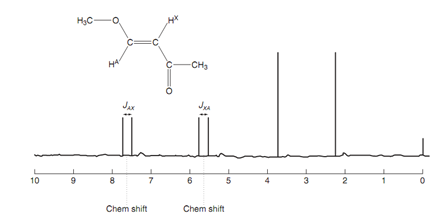Coupling constants:
If we look now at the signal for X, similar thing occur except the secondary magnetic ?elds are now because of the different orientations of proton A. The coupling constant for this signal is JXA and must be equal in magnitude to JAX.

Figure: Coupling constants.
Now Let us look at a more complicated condition where we have a methyl group related to a methine group (see 1, 1-dichloroethane). In this condition, we have three similar methyl protons (X) separated via three bonds from one CH proton (A). The spectrum depicts two signals. The signal for the methyl protons is a doublet at 1.55 ppm, whereas the signal for the methine proton is a quartet at 5.05 ppm.
We look very first at the effect the methine proton has on the three equivalent methyl protons. The methine proton can comprise two possible orientations - either with the ?eld or against it. The secondary magnetic ?eld related with these orientations is transmitted to the methyl protons by the connecting bonds that mean that the methyl protons are affected by two equal but opposing secondary magnetic ?elds. The signal for the methyl protons is split into a doublet.